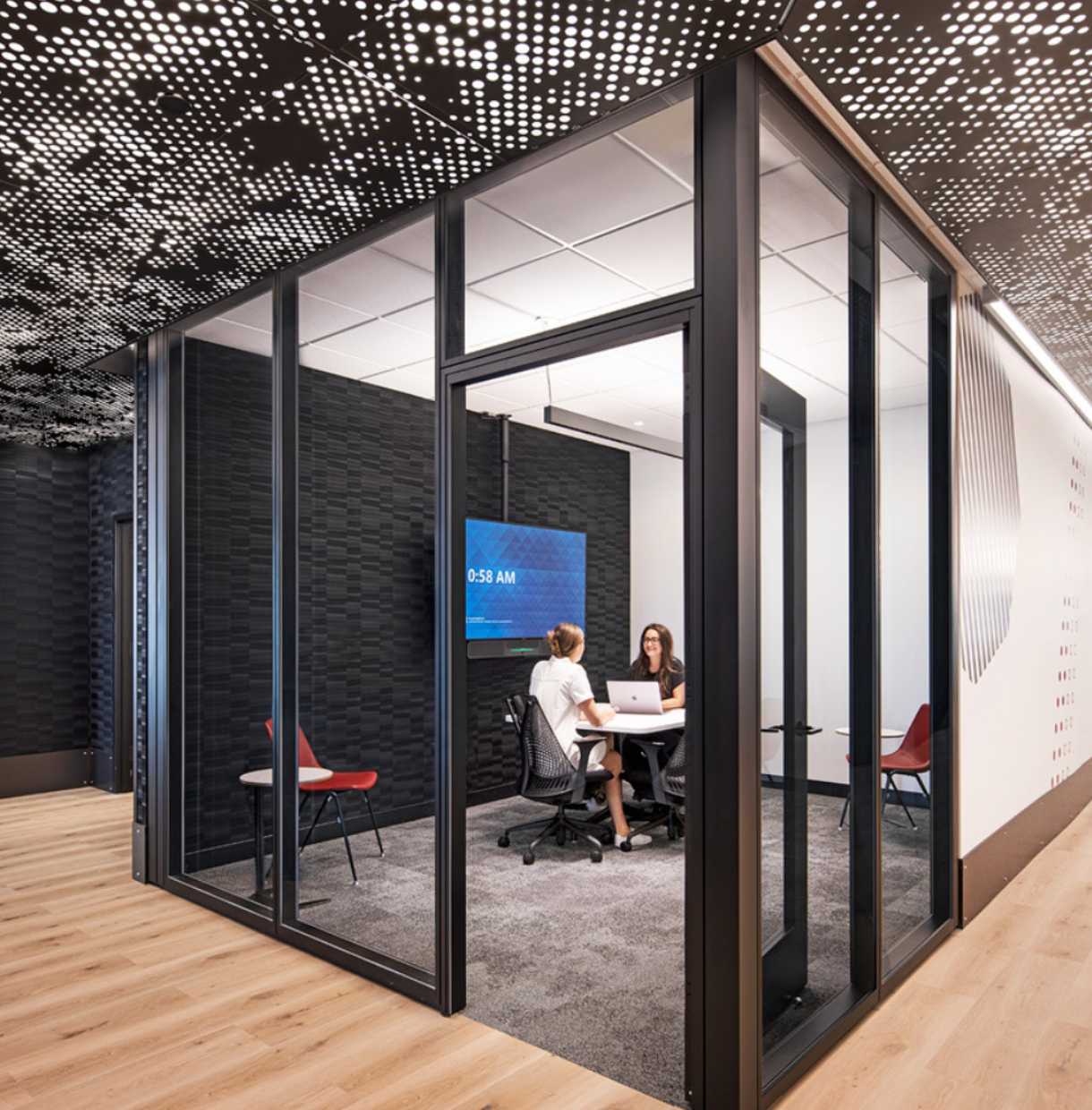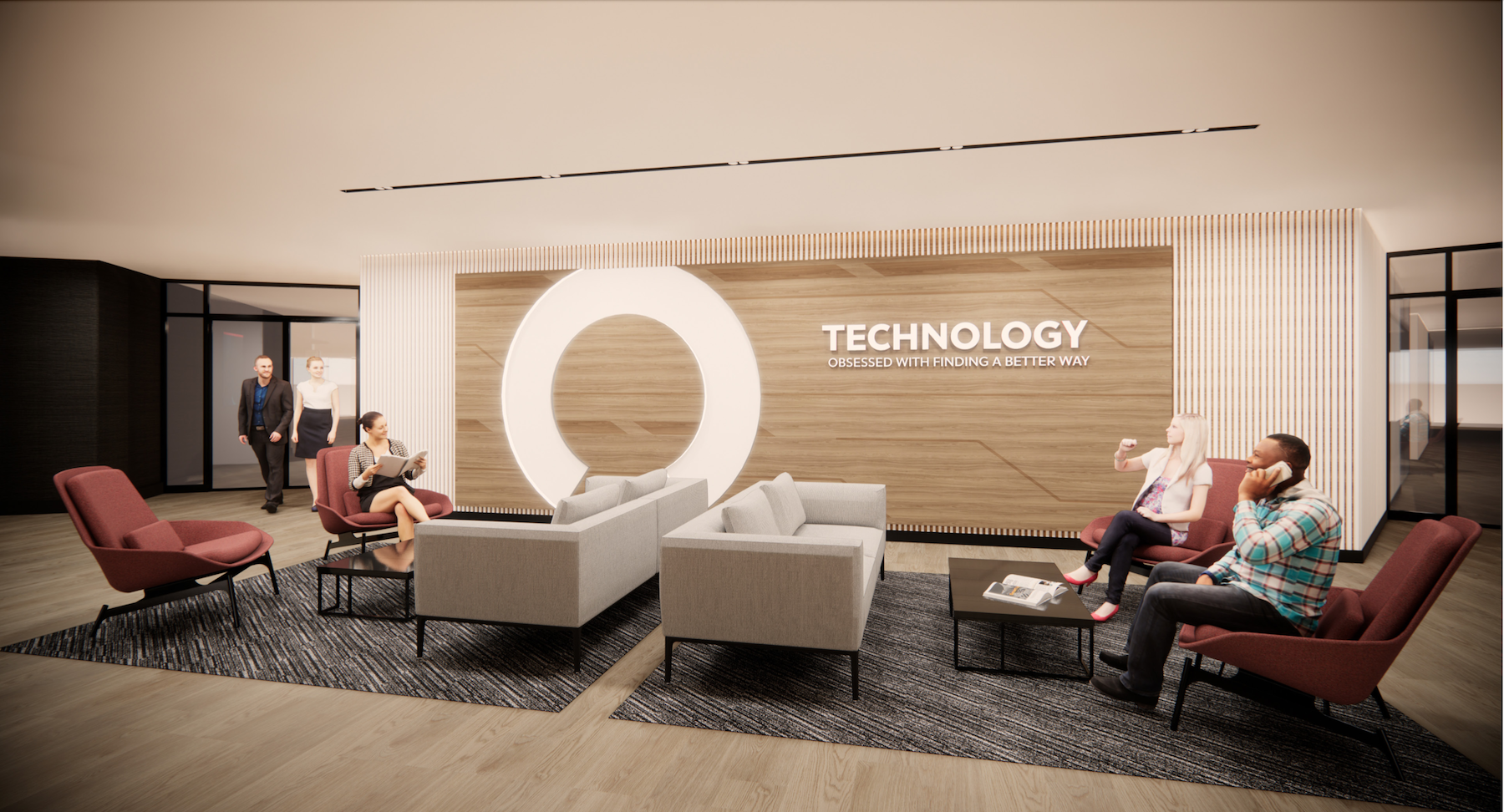The Rock Family of Companies, which includes Rocket Mortgage and Quicken Loans, is one of Detroit’s largest employers, with 17,000 workers. Over the past several months, many of those employees have been returning to their offices, more than 1 million sf of which in several buildings were renovated in 2020, while those spaces were closed because of the coronavirus pandemic.
Pophouse—a nine-year-old interior design studio owned by Jennifer Gilbert,, the wife of Dan Gilbert, Rock’s chairman and majority owner—came up with the design concept for this renovation project through a pilot program at Rocket Mortgage Technology’s four-story 288,000-sf headquarters in the One Campus Martius Building that, initially, involved around 40 employees for several months in 2019, and then was refined to the point where it could be rolled out for 2,000 workers.
“The goal was to offer a destination and collaborative space for innovation,” says Mike Malloy, Chief Amazement Officer for Rock Central, a professional services firm that’s part of Rocket Companies. Jennifer Janus, Pophouse’s President, says her firm’s mission on this project was to create a positive impact on employees and visitors by using data and metrics to inform its design.
Five parameters defined the pilot’s design:
•Culture + Community, where branded moments demonstrate organizational identity;
•Team + Wellness, where workers are exposed to the outdoors and natural light;
•Collaboration that allows team members to work together within new orientations;
•Tech Integration that reduces extraneous equipment and facilitates team meetings wherever employees are working;
•Flexible Amenity Settings, where private offices are designed with small or larger gathering tables, where team ownership of spaces allows each group to manage its physical assets, and where communal amenities, like kitchens and conference rooms, support all individuals on that floor.
OFFICES WERE BEING USED SPARSELY

A survey of employees for the pilot found that 90 percent would use a quiet place at work if it were made available, and that 80 percent wanted more conference rooms. More significant were the findings that 36 percent of room needs per hour were for two-person meetings, and that on an average day 30 percent of the office’s tech team does not come into the building, and that even at its highest level, 20 percent aren’t in the office on a given day.
Pophouse, working with the GC Braun Construction Group and the architect Rossetti, tested all kinds of things: smaller desk surfaces, collaborative zones and software, training areas, additional monitors for teams to use, desk utilization, and digital behaviors.

It found that workers could acclimate themselves to a smaller, five-ft desk surface; that they preferred high-top tables to casual seating in collaborative areas; that non-bookable team spaces were “highly valued” and led to different employee behaviors and team rituals; that flexible conditions resonated positively; that new technology should be deployed and tested thoroughly; and that finding solutions that permit onsite and remote work transparently was imperative.
The test space contained new types of work settings for the team to leverage. These included one-on-one spaces, smaller collaborative spaces with soft seating, quiet areas, so-called “touchdown” spaces for spontaneous and quick interaction, and enhanced tech to improve the remote working experience.
Pophouse’s “neighborhood” concept included determining a kit of parts creating a “home base” for team members, which would allow an “ecosystem” of work settings for individuals to choose from. The concept reduced the quantity of workstations but increased the number of overall seats per floor.
OFFICE-TO-RESIDENTIAL COULD BE NEXT OPPORTUNITY

The firm’s pilot design—which assumes a hybrid work model—revolves around these principles: culture is key, variety over repetition, full sensory performance that reduces distractions, a spectrum of shared and individual spaces, a “playground of perspective” where teams share a “home,” the smart home that functions seamlessly with the office space, a clutter-free workspace, authenticity, and “driven simplicity.”
As the design was applied to offices in other Rock-owned buildings, Pophouse worked with building teams that included the AE firm NORR and Whiting-Turner Construction.
Pophouse, with 30 employees, over the years has completed several thousand large and small projects for Gilbert’s businesses in Detroit, Cleveland, and Miami. But Pophouse still gets 40 percent of its work from other clients. Janus foresees opportunities doing more work in states like California and Florida that would include converting vacated office spaces to residential. Malloy notes that his company is “intrigued” by a pending bill in Washington D.C. that would provide funding for such conversions.
Related Stories
| May 25, 2011
Developers push Manhattan office construction
Manhattan developers are planning the city's biggest decade of office construction since the 1980s, betting on rising demand for modern space even with tenants unsigned and the availability of financing more limited. More than 25 million sf of projects are under construction or may be built in the next nine years.
| May 18, 2011
Lab personnel find comfort in former Winchester gun factory
The former Winchester Repeating Arms Factory in New Haven, Conn., is the new home of PepsiCo’s Biology Innovation Research Laboratory.
| May 16, 2011
Virtual tour: See U.S. Green Building Council’s new LEED Platinum HQ—and earn CE credits
A virtual tour of the U.S. Green Building Council's LEED Platinum HQ is available. The tour features embedded videos, audio podcasts, and information on building materials and products used throughout the space. By taking the virtual tour, professionals can earn GBCI Continuing Education hours for the LEED AP with specialty and LEED Green Associate credentials.
| May 11, 2011
DOE releases guide for 50% more energy-efficient office buildings
The U.S. Department of Energy today announced the release of the first in a new series of Advanced Energy Design Guides to aid in the design of highly energy efficient office buildings. The 50% AEDG series will provide a practical approach to commercial buildings designed to achieve 50% energy savings compared to the commercial building energy code used in many areas of the country.
| May 10, 2011
Google hires Ingenhoven Architects to design new Mountain View office
The current Googleplex is straining at the seams and yet the company is preparing its biggest hiring surge ever, so Google decided now’s the time to build its own office space—a first for the Internet giant. The company hired Ingenhoven Architects, a German firm that specializes in sustainable architecture, to create plans for what could be a 600,000-sf office.
| Apr 13, 2011
Office interaction was the critical element to Boston buildout
Margulies Perruzzi Architects, Boston, designed the new 11,460-sf offices for consultant Interaction Associates and its nonprofit sister organization, The Interaction Institute for Social Change, inside an old warehouse near Boston’s Seaport Center.
| Apr 13, 2011
Red Bull Canada HQ a mix of fluid spaces and high-energy design
The Toronto architecture firm Johnson Chou likes to put a twist on its pared-down interiors, and its work on the headquarters for Red Bull Canada is no exception. The energy drink maker occupies 12,300 sf on the top two floors of a three-story industrial building in Toronto, and the design strategy for its space called for leaving the base building virtually untouched while attention was turned to the interior architecture.












